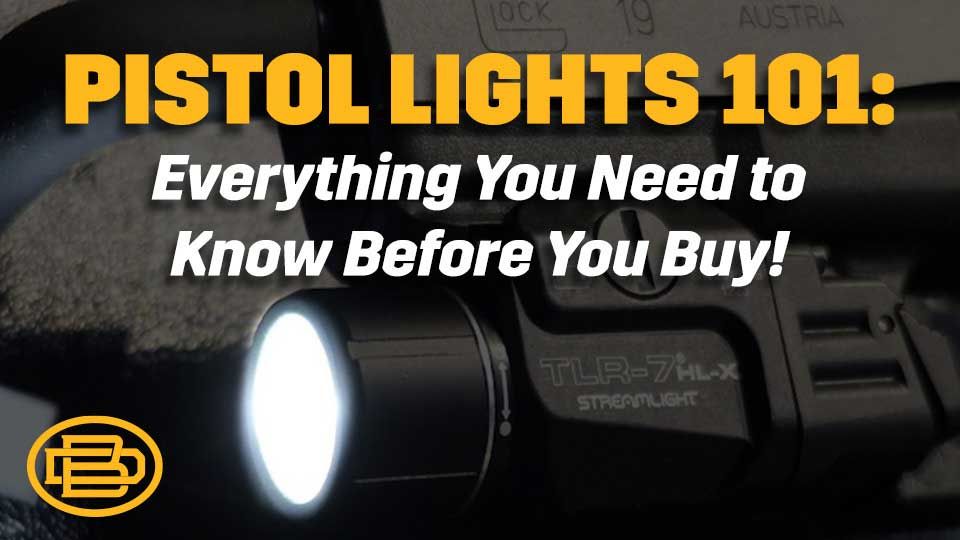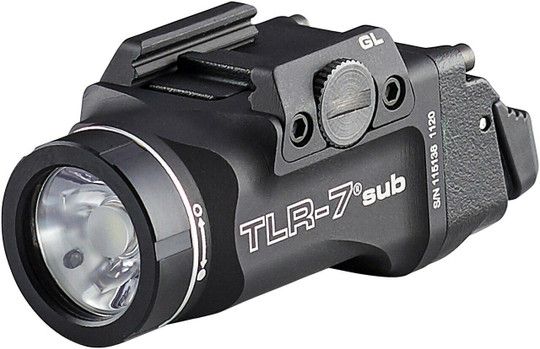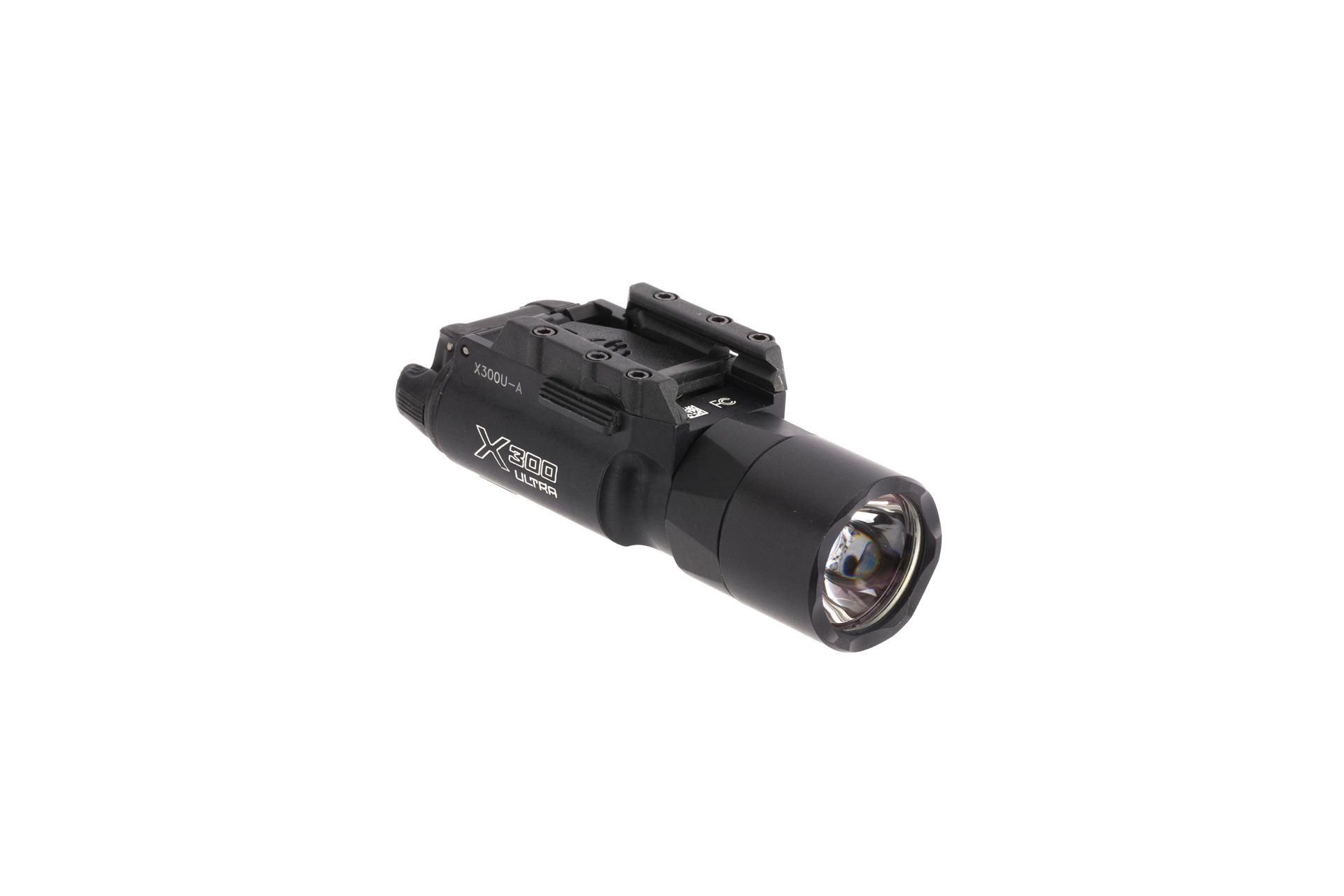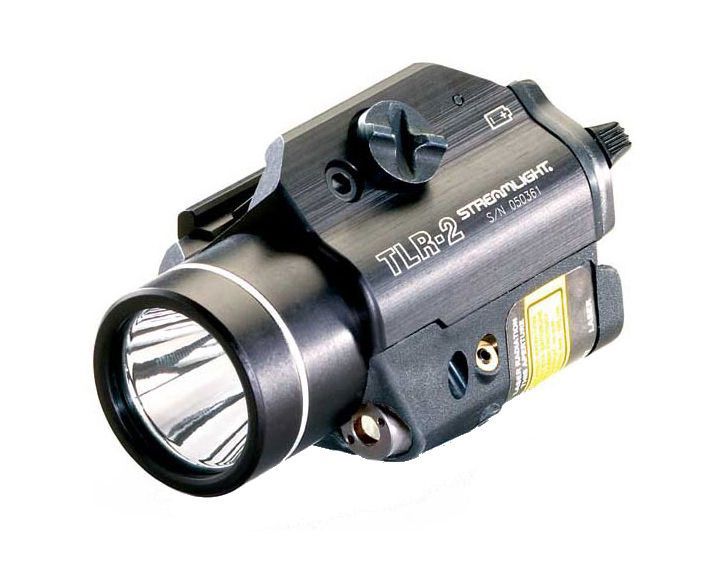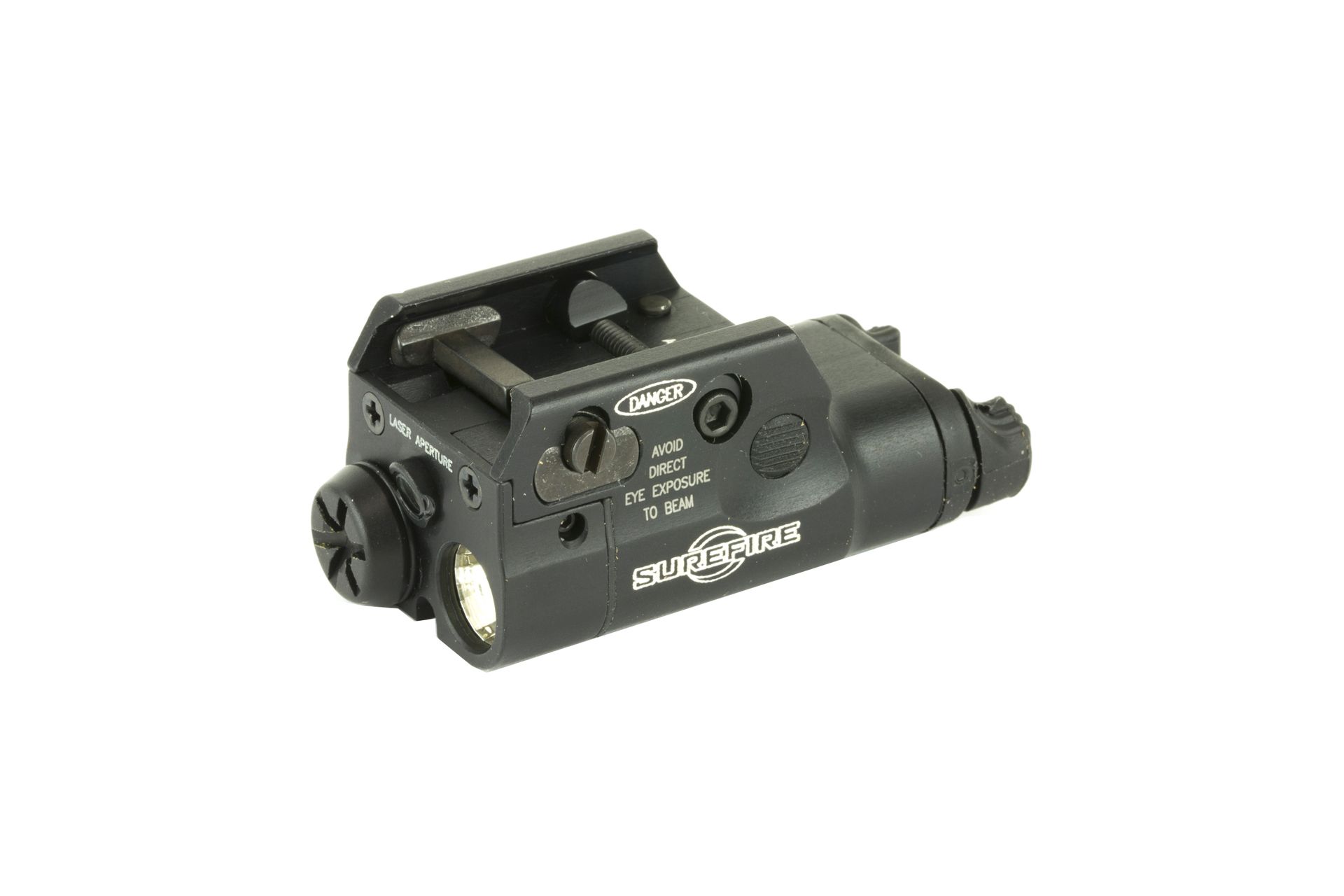Pistols
Pistol Lights 101: Everything You Need to Know Before You Buy
Table of Contents
A quality pistol light can make all the difference regarding personal defense and tactical operations or enhance your shooting experience. Whether you’re a seasoned shooter or just getting started, understanding the ins and outs of pistol lights is crucial to making the right choice. At Dirty Bird Industries, we know how critical it is to have reliable equipment you can trust, especially when the stakes are high. This guide explains everything you need to know before buying a pistol light—covering types, performance metrics, mounting considerations, and top brands.
A pistol light isn’t just about illuminating targets; it’s about boosting your situational awareness, increasing accuracy in low-light conditions, and adding a layer of safety and preparedness to your firearm setup. From evaluating lumens and beam patterns to understanding critical features like strobe modes and durability, this guide aims to shed light—pun intended—on every essential factor. By the end, you’ll be equipped with the knowledge to select the best pistol light tailored to your specific needs and preferences. Let’s dive in!
Why a Pistol Light is Essential for Self-Defense
A pistol light is more than just an accessory; it’s a critical self-defense tool that can make a significant difference when faced with a threat in low-light conditions. Criminals often operate under the cover of darkness; without proper illumination, you may find yourself at a severe disadvantage. A pistol light lets you identify potential threats, reducing the chances of mistaken identity or accidental discharge. Positive target identification is crucial in high-stress situations, and having a bright, focused beam ensures you know exactly what you’re dealing with.
A pistol light can temporarily disorient an attacker, giving you a crucial moment to react. Many modern lights offer high-lumen output capable of producing an intense beam that disrupts an intruder’s vision, buying you valuable seconds to assess, issue commands, or defend yourself if necessary.
Pistol lights also enhance your shooting accuracy. By providing a clear sight picture and illuminating your target, you gain better aim control and situational awareness. This is especially vital in dynamic, unpredictable encounters where every fraction of a second and shot placement matters. In essence, a pistol light empowers you to confidently respond, making it an indispensable part of a comprehensive self-defense strategy.
Handheld vs. Weapon-Mounted: Pistol Light Types
When choosing a light for self-defense or tactical use, there are two primary options: handheld and weapon-mounted lights. Each has its advantages and considerations, making it essential to understand their differences.
Handheld lights offer flexibility and are a versatile tool beyond just shooting scenarios. They allow you to use light in a non-lethal capacity, such as scanning an area without pointing your firearm. This added discretion can be beneficial in situations where drawing a weapon isn’t necessary. Handheld lights also enable various grip techniques, allowing the user to hold the light and firearm separately for more controlled illumination angles.
On the other hand, weapon-mounted lights free both hands, which is essential in high-stress defensive situations. With a light directly affixed to your firearm, you can quickly engage and illuminate a target without sacrificing grip or aim. This setup ensures consistent lighting with every firearm movement, enhancing accuracy and response time in dark environments. However, weapon-mounted lights can add bulk and may require specific holsters.
Ultimately, the choice between handheld and weapon-mounted lights comes down to personal preference, intended use, and the need for hands-free operation or adaptability in dynamic environments.
Understanding Lumens, Beam Patterns, and Runtime
When selecting a light for your firearm, understanding key performance metrics such as lumens, beam patterns, and runtime is essential for making an informed decision. Lumens measure the total amount of visible light emitted by the light source. A higher lumen count translates to a brighter output, which can be crucial for effectively illuminating a target or environment in low-light conditions. However, brighter isn’t always better; extreme brightness can create too much glare or backscatter in enclosed spaces, potentially obscuring your vision.
Beam patterns are equally important. The beam pattern determines how light is distributed—either in a concentrated “hot spot” with a longer reach or in a wide flood that covers more area. A focused beam is ideal for long-distance target identification, while a wider beam offers better situational awareness in close-quarters engagements. Many lights balance these features, offering a combination beam that caters to different scenarios.
Runtime indicates how long the light can operate on a set of batteries. Consider your expected usage: tactical lights with high-lumen output often have shorter runtimes, requiring more frequent battery changes or recharges. Striking the right balance between brightness, beam pattern, and runtime is critical for achieving optimal performance and reliability under different conditions.
How to Choose the Right Pistol Light for Your Gun
Choosing the right light for your firearm involves evaluating various factors to ensure optimal performance and compatibility. Start by considering the light’s size and weight. A compact, lightweight light is preferable for concealed carry or personal defense, as it minimizes added bulk and maintains a balanced feel when aiming or maneuvering. Larger, more powerful lights might be suitable for home defense or tactical use but can affect the firearm’s handling.
Mounting compatibility is crucial as well. Ensure that the light is designed to fit securely on your gun’s rail system. Many models come with adjustable mounts or are tailored for specific firearm brands. The last thing you want is a loose or unstable attachment during critical moments.
Pay attention to output specifications like lumens and beam patterns. A light with a wide beam pattern and moderate brightness may be more effective for close-quarters engagements. Conversely, outdoor or longer-range scenarios may require a higher-lumen light with a focused beam.
Consider additional features such as ambidextrous controls, strobe functions, and waterproofing. Ease of use in high-stress situations is critical, and quick, intuitive activation can make all the difference. Ultimately, the best light is one that complements your firearm’s role, fits your carry style, and meets your performance needs.
Key Features to Look for in a Pistol Light
When selecting a light for your firearm, focusing on key features can make all the difference in performance and usability. One critical factor is lumens and brightness output. Higher lumens offer greater visibility in low-light situations, but striking a balance is crucial; too much brightness can produce glare or affect your night vision in close quarters. Ideally, you would like to choose a light that offers adjustable settings, allowing you to tailor brightness to different environments.
Beam pattern is another important feature. A focused beam allows for longer-range identification, while a wider beam gives better peripheral visibility, which is helpful for situational awareness. Many quality lights combine these features to offer a bright central hotspot and a wide spill.
Ease of activation is paramount, especially in high-stress situations. Look for models with ambidextrous switches or controls that are easy to reach and engage without compromising your grip on the firearm. Battery type and runtime should also be considered; a longer runtime ensures your light will perform when needed most, and rechargeable options can reduce ongoing costs.
Other important features include durability—such as waterproofing, impact resistance, and heat management—and potential add-ons like strobe functions for disorienting threats. The right combination of these features ensures reliability, safety, and confidence in critical moments.
Top Pistol Light Brands and Models Compared
Regarding trusted names in the world of firearm lights, SureFire and Streamlight stand out as industry leaders, renowned for their quality, performance, and reliability. SureFire produces rugged, high-output lights that excel in tactical and defensive applications. Their lights, such as the SureFire X300 Ultra, offer exceptional brightness, durable aluminum construction, and intuitive controls. The X300’s high-lumen output provides superior target illumination and a consistent, reliable beam, making it a favorite among military and law enforcement personnel.
Streamlight is another top-tier brand known for producing high-performing lights at a more affordable price than SureFire. The Streamlight TLR-1 HL offers a high-lumen output and robust durability while maintaining a lightweight design, making it ideal for everyday carry, home defense, and law enforcement applications. Streamlight products are often praised for their balance of price and performance, offering dependable features for various needs.
For a more budget-friendly option, Holosun offers a solid lineup of lights, known for combining innovation with affordability. While not as established as SureFire or Streamlight in the light market, Holosun focuses on delivering practical features, impressive light output, and reliable performance. Their products are built to be durable and functional, making them a great choice for users seeking dependable lighting solutions on a tighter budget without sacrificing quality.
Top Budget Pistol Lights Under $200 for 2024
For those looking to enhance their firearm setup without breaking the bank, there are excellent budget-friendly light options available in 2024. Among them, the Streamlight TLR-1 HL stands out as a top contender, offering exceptional value at approximately $189. Renowned for its dependability and performance, the TLR-1 HL provides an impressive 1,000 lumens of brightness, delivering a focused beam with excellent reach and peripheral illumination. This makes it highly effective for home defense, concealed carry, and even tactical applications. Its lightweight aluminum construction ensures durability without adding excessive bulk, while the ambidextrous switch allows for easy activation, regardless of your shooting hand preference.
Beyond Streamlight, other budget-friendly pistol lights under $200 also offer excellent features. Models from Holosun, for example, emphasize innovative, user-friendly designs and durability at a lower price point. While not quite as established as Streamlight in the lighting market, Holosun provides reliable performance and good light output for a variety of needs. Whether you’re seeking high-lumen output, robust durability, or compact and lightweight designs, finding a quality pistol light under $200 is more achievable than ever. These options ensure you can enhance your firearm’s functionality and security without stretching your budget too far.
Final Thoughts: Choosing the Perfect Pistol Light for You
Choosing the perfect light for your firearm ultimately depends on your preferences, intended use, and individual shooting needs. Consider factors like size, weight, mounting options, and brightness levels that best fit your style—whether you prioritize quick target acquisition for home defense, compact size for concealed carry, or tactical versatility. Balancing key features such as lumens, beam pattern, runtime, and durability is essential to ensuring reliable performance in any situation you may face.
It’s important to remember that every shooter’s needs are unique, and the right light for one person may differ from another’s choice. Test out different options whenever possible, and weigh the pros and cons based on your requirements and environment. The peace of mind and added confidence you’ll gain from selecting the right light cannot be overstated—it’s a decision that impacts your safety and performance in critical moments.
For top-quality lights that cater to a wide range of preferences and budgets, check out the pistol lights available at Dirty Bird Industries. Our carefully curated selection includes trusted brands and innovative options, making finding the perfect light to enhance your firearm setup easier than ever. Illuminate your path to better shooting and greater security today!
Frequently Asked Questions about Pistol Lights
1. Do all lights fit any firearm?
- Answer: No, not all lights are universally compatible with every firearm. Different lights are designed to fit specific rail systems, such as Picatinny, Weaver, or proprietary rails used by certain manufacturers. It’s important to ensure that the light you select fits securely on your firearm’s rail. Some lights offer adjustable mounts or adapters for a versatile fit, but stability and security are key for proper performance.
2. Is a high-lumen light always better?
- Answer: Not necessarily. While high-lumen output can provide brighter illumination, too much brightness can create glare or reflection in enclosed spaces, potentially obscuring your vision. Consider the intended use of your light: a lower-lumen setting may be more suitable for indoor or close-range scenarios, while higher lumens are ideal for outdoor or long-distance applications.
3. What’s the difference between lumens and beam patterns?
- Answer: Lumens measure the total visible light emitted by the source, indicating brightness. Beam patterns determine how light is distributed—either in a focused “hot spot” for long-range illumination or a wider flood pattern for peripheral vision and situational awareness. Some lights offer a combination beam that balances these aspects for versatile performance.
4. Can I use my light underwater?
- Answer: This depends on the light’s waterproof rating. Some lights are water-resistant, meaning they can handle splashes or rain, while others are fully submersible (e.g., IPX7 or IPX8 ratings). If you need a light for wet conditions, ensure it has an adequate waterproof rating to withstand submersion or exposure to moisture.
5. Do I need special tools to attach a mounted light?
- Answer: Most modern weapon-mounted lights are designed for easy, tool-free attachment, often using quick-detach levers or thumb screws. However, some models may require basic tools, such as an Allen wrench or screwdriver, to achieve a secure fit. Consult the manufacturer’s instructions to determine if any tools are necessary.
6. Are handheld lights better than mounted ones?
- Answer: It depends on your needs. Handheld lights offer flexibility, allowing you to illuminate areas without pointing your firearm. Weapon-mounted lights provide hands-free operation, ensuring consistent illumination as you move and aim. Consider your intended use and whether you prioritize versatility or a hands-free setup.
7. What runtime should I look for in a light?
- Answer: The runtime depends on your expected use. High-lumen lights often have shorter runtimes but provide more intense illumination. If you anticipate extended use, consider lights with longer runtime capabilities or rechargeable options to reduce costs. It’s important to balance runtime with output to ensure reliable performance.
8. Do pistol lights come with strobe functions?
- Answer: Many lights offer strobe functions designed to disorient attackers, providing a tactical advantage in defensive situations. While this feature can be valuable, consider whether it suits your needs, as some users prefer a straightforward on/off function for simplicity.
9. What materials should I look for in a light?
- Answer: High-quality lights are typically constructed from durable materials like aircraft-grade aluminum, providing impact resistance and corrosion protection. Look for lights with tough lenses, such as tempered glass or polycarbonate, and consider models that offer shockproof and weather-resistant designs for added durability.
10. Are there legal restrictions on using weapon-mounted lights?
- Answer: In most regions, there are no specific legal restrictions on using weapon-mounted lights for personal defense. However, firearm laws vary by jurisdiction. Make sure to comply with your local, state, and federal regulations regarding firearm accessories and their use, especially if used in a public setting or carried concealed.
Additional References: ARBuildJunkie
